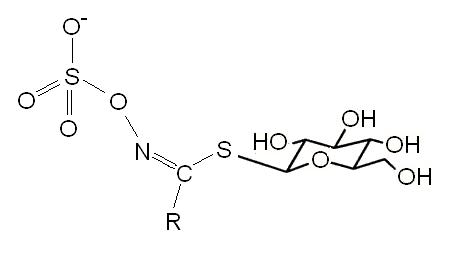Water cress is part of the same group of cruciferous vegetables as broccoli, cauliflower, brussel sprouts and kale (family brassicaceae). These vegetables are a rich source of dietary glucosinoliates which are a class of sulphur and nitrogen containing glycosides (figure 1). Glucosinolates are converted to isothiocyanates by the action of the plant enzyme myrosinase, which cleaves the glucose group from the glucosinalates. Myrosinase and glucosinolates are stored in separate parts of the plant and are only brought into direct contact when the plant undergoes tissue injury. This forms part of the plants natural defence against predators. Isothiocyanates are of interest to human nutrition because they have potent anticancer effects. Isothiocyanates are able to inhibit the formation of cancer because they increase the phase II detoxification pathway and can induce apoptosis of cancer cells.
 Figure 1. The chemical structure of the glucosinolates. R represent a variable group.
Figure 1. The chemical structure of the glucosinolates. R represent a variable group.
Water cress contains one of the highest glucosinolate contents of any vegetable, as well as high concentrations of the carotenoids β-carotene and lutein. Water cress should therefore possess favourable anticancer properties as well as strong antioxidant effects in humans. Research published in the American Journal of Clinical Nutrition in 20071 tested the cancer protective effects of water cress by feeding 60 smokers and non‑smokers 85 g of fresh water cress a day for 8 weeks. The researchers then tested the lymphocytes in blood samples of the subjects for various parameters of DNA damage. Subjects who ate water cress had plasma samples that showed a 17 % reduction in basal DNA damage, a 23 % reduction in oxidative purine DNA damage and a 9 % reduction in DNA damage when exposed to hydrogen peroxide. In smokers the beneficial effect was even greater.
There is considerable scientific evidence that cruciferous vegetables reduce the risk of many types of cancer such as prostate, lung, colon and lymph. Including as many different types of plant from the brassicaceae family into a healthy diet is recommended because it is at present unclear as to which cruciferous vegetables are the most beneficial. As well as isothiocyanates, the cruciferous vegetables are also good sources of carotenoids. The same researchers above, also showed that water cress supplementation increased the plasma levels of β-carotene and lutein in the subjects by 33 % and 100 % respectively. The fact that the water cress was more beneficial to smokers than non‑smokers is likely just a simple reflection of the increased toxic burden associated with smoking. However, it does nicely illustrate the protective effect that cruciferous vegetables may have on individuals living in areas of high pollution.
RdB
